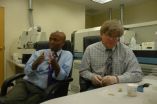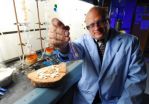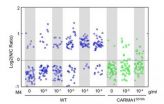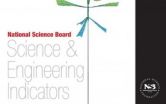Communicating with the world across the border
2014-05-15
(Press-News.org) Stanford, CA—All living cells are held together by membranes, which provide a barrier to the transport of nutrients. They are also the communication platform connecting the outside world to the cell’s interior control centers. Thousands of proteins reside in these cell membranes and control the flow of select chemicals, which move across the barrier and mediate the flux of nutrients and information. Almost all of these pathways work by protein handshakes--one protein “talking” to another in order to, for example, encourage the import of a needed nutrient, to block a compound from accumulating to a toxic level, or to alert the cell’s interior to changes in the outside environment.
Little was known about the relationships among membrane proteins and interior proteins. A team led by Carnegie's Wolf Frommer has revealed how membrane proteins were networked with each other and with the signaling proteins inside the cell. Their work is published in Science.
The messages conveyed to membrane proteins by signaling proteins, and vice versa, form the basis of communication between cells within an organism, as well as between the organism and the outside world. To gain insight into this protein-protein messaging across and within membranes, the Frommer team carried out a massive screen for protein-protein interactions between predicted membrane proteins and predicted signaling proteins. They focused on a mustard green called Arabidopsis, the reference organism used by plant biologists in their research.
Many millions of tests were performed and over 10,000 interactions were discovered. The work is the first of its kind in any organism and will have implications for both plant and animal sciences.
Technical difficulties in studying membranes mean that only a few cross-membrane protein-to-protein signals are known. Both plant and human genomes contain thousands of membrane proteins whose functions remain mysterious. Similar techniques to identify membrane protein interactions have been used before to identify select membrane transporters. But Frommer's team developed a deeper process that was able to yield a greater diversity of results. The vast majority of the thousands of potential membrane protein-signaling protein interactions they found had never before been identified. The team's aim was to use their new protein interaction network to identify interactions important for protein-protein messaging and help assign possible functions to these “unknown” membrane proteins.
"Our findings can serve as an important resource for gene discovery and will be applicable to the animal kingdom, as well as to plants," Frommer said. "In plants, it could help lead to discoveries that will improve crop yields."
INFORMATION:
This work was supported by the NSF.
The Carnegie Institution for Science is a private, nonprofit organization headquartered in Washington, D.C., with six research departments throughout the U.S. Since its founding in 1902, the Carnegie Institution has been a pioneering force in basic scientific research. Carnegie scientists are leaders in plant biology, developmental biology, astronomy, materials science, global ecology, and Earth and planetary science. END
ELSE PRESS RELEASES FROM THIS DATE:
Quantum simulator gives clues about magnetism
2014-05-15
Assembling the puzzles of quantum materials is, in some ways, like dipping a wire hanger into a vat of soapy water, says CIFAR (Canadian Institute for Advanced Research) Fellow Joseph Thywissen (University of Toronto).
Long before mathematical equations could explain the shapes and angles in the soap foams, mathematicians conjectured that soap films naturally found the geometry that minimized surface area, thus solving the problem of minimal surfaces. They could be created simply by blowing soap bubbles.
At the University of Toronto's Ultracold Atoms Lab, Thywissen ...
UNM plays major role in establishing link between ancient and modern Native-Americans
2014-05-15
Her name is Naia, and for thousands and thousands of years, the skeleton of this young woman was buried underwater in an elaborate cave system in the Yucatan Peninsula after she had apparently fallen into what was then a dry deep pit.
Now, a team of researchers, including Professor Yemane Asmerom and Research Scientist Victor Polyak at the University of New Mexico's Department of Earth and Planetary Sciences, have accurately determined the age of the oldest-known, well-preserved human skeleton. Naia was one of the earliest inhabitants of the Americas and has helped resolve ...
Making money from lignin: Roadmap shows how to improve lignocellulosic biofuel biorefining
2014-05-15
When making cellulosic ethanol from plants, one problem is what to do with a woody agricultural waste product called lignin. The old adage in the pulp industry has been that one can make anything from lignin except money.
A new review article in the journal Science points the way toward a future where lignin is transformed from a waste product into valuable materials such as low-cost carbon fiber for cars or bio-based plastics. Using lignin in this way would create new markets for the forest products industry and make ethanol-to-fuel conversion more cost-effective.
"We've ...
UH researchers find definitive evidence of how zeolites grow
2014-05-15
Researchers have found the first definitive evidence of how silicalite-1 (MFI type) zeolites grow, showing that growth is a concerted process involving both the attachment of nanoparticles and the addition of molecules.
Both processes appear to happen simultaneously, said Jeffrey Rimer, an engineering professor at the University of Houston and lead author of a paper published Thursday in the journal Science.
He said a second component to the research could have even more lasting impact. He and researcher Alexandra I. Lupulescu used a new technique allowing them to view ...
Anti-craving drug and counseling lower alcohol harm in homeless, without sobriety demands
2014-05-15
Chronically homeless, alcohol-dependent individuals might benefit from a new intervention that does not require them to stop or even reduce drinking, according to the results of a preliminary study in Seattle.
Participants in the 12-week pilot program received monthly injections of an anti-craving medication, extended-release naltrexone. They also met regularly with study physicians to set their own goals for treatment and to learn to be safer in their use of alcohol.
"Abstinence-based alcohol treatment has not been effective for or desirable to many homeless people ...
UTHealth research: Children of parents in technical jobs at higher risk for autism
2014-05-15
HOUSTON – (May 15, 2014) – Children of fathers who are in technical occupations are more likely to have an autism spectrum disorder, according to researchers at The University of Texas Health Science Center at Houston (UTHealth).
The findings will be presented Friday at the International Meeting for Autism Research in Atlanta.
During participation in the LoneStar LEND program, first author Aisha S. Dickerson, Ph.D., a researcher at UTHealth's Center for Clinical and Translational Sciences, used the United States government's Standard Occupational Classification system. ...
B cells produce antibodies 'when danger calls, but not when it whispers'
2014-05-15
The immune system's B cells protect us from disease by producing antibodies, or "smart bullets," that specifically target invaders such as pathogens and viruses while leaving harmless molecules alone. But how do B cells determine whether a threat is real and whether to start producing these weapons?
An international team of life scientists shows in the May 16 issue of the journal Science how and why these cells respond only to true threats.
"It is critical for B cells to respond either fully or not at all. Anything in between causes disease," said the study's senior ...
Researchers show emissions from forests influence very first stage of cloud formation
2014-05-15
PITTSBURGH—Clouds play a critical role in Earth's climate. Clouds also are the largest source of uncertainty in present climate models, according to the latest report of the Intergovernmental Panel on Climate Change. Much of the uncertainty surrounding clouds' effect on climate stems from the complexity of cloud formation.
New research from scientists at the CLOUD (Cosmics Leaving OUtdoor Droplets) experiment at CERN, including Carnegie Mellon University's Neil Donahue, sheds light on new-particle formation — the very first step of cloud formation and a critical component ...
New data show how states are doing in science
2014-05-15
The newly updated, online, interactive state data tool allows policymakers, educators and other users to discern trends in education, science and research in each of the 50 states. This free resource supplements the state data in the 2014 Science and Engineering Indicators report, the premier source of information and analysis of the nation's position in science and engineering education and research. The biennial report is published by the National Science Board, the policy making body of the National Science Foundation (NSF).
The tool features 59 state indicators of ...
UH Case Medical Center neurosurgeon uses depth electrodes for speech mapping
2014-05-15
CLEVELAND -- At the 2014 American Association of Neurological Surgeons Annual Meeting, neurosurgical researchers from University Hospitals (UH) Case Medical Center presented results from a small study looking at deep brain electrode implantation as a possible alternative to the traditional WADA test used prior to epilepsy surgery.
The WADA test is considered the gold standard for identifying the side of the brain for speech dominance. In the WADA test, doctors put one half of a patient's brain to sleep for a few minutes using medication and then have the patient read ...








